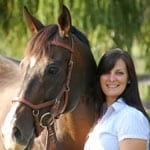Fix Easy Keeper Feeding Mistakes
- Topics: Hay, Horse Care, Nutrition, Nutrition-Related Problems, Obesity

Managing easy keepers can be challenging. Ensuring horses get the nutrients they need without becoming overweight—and, thus, at increased risk for developing potentially dangerous health issues—can seem like an impossible task.
Easy-keeper owner Shannon Pratt-Phillips, PhD, a professor of equine nutrition at the North Carolina State University Department of Animal Science, in Raleigh, shares the top mistakes she sees owners of easy keepers making and how to get back on track.
The mistake: allowing unchecked pasture access.
“Pasture is like a buffet for horses,” said Pratt-Phillips.
Not only can pasture have higher calorie density than most types of hay, but it can also accumulate sugars that are problematic for some horses.
“Perhaps the biggest issue with pasture if you have an overweight or easy-keeper-type of horse is that it is nearly impossible to accurately estimate how much the horse is eating,” she said. “This makes balancing the rest of the diet very difficult.”
The Fix: Pratt-Phillips said grazing muzzles can be effective at reducing pasture intake while still allowing the horse to have ample turnout time and space. It’s important to keep a close eye on muzzled horses. Food-motivated horses can remove or damage the muzzle, rendering it ineffective.
Another option is turning horses out in a drylot with hay, which lets them move around freely without risking potentially problematic pasture intake.
The mistake: not knowing what’s in hay.
Just like you can’t judge a book by its cover, you can’t judge hay quality or composition by looking at it. And, for easy keepers, knowing exactly what’s in forage is key to keeping them healthy and their weight under control.
The Fix: Collect a representative hay sample and send it to a laboratory for analysis.
“This can be challenging if your horse is kept somewhere where the hay changes frequently, but it is still useful to check it now and then,” Pratt-Phillips said. “You might be surprised at how much you could be underfeeding or overfeeding a particular nutrient, just from the hay.”
The mistake: not weighing feed.
Just as important as knowing what’s in feed and forage is knowing how much you should offer an easy keeper.
“Different flakes of hay—even from the same bale—can weigh different amounts, and scoops of different products will have different weights,” said Pratt-Phillips. “If we are trying to monitor calorie intake, we really need to account for all of those minor fluctuations, so weighing feed is critical.”
The Fix: Make a scale your new best friend! For grain, weigh an empty bucket before adding the amount of concentrate the horse gets each day; subtract the weight of the bucket to find out how many pounds the horse eats. Then, mark the volume on a feed scoop for easy measuring on a day-to-day basis.
For hay, place the horse’s hay ration in a garbage bag or haynet and weigh it (a garbage bag probably won’t affect the numbers much, but a haynet could weigh a pound or two, so use your best judgment on whether to determine its weight separately and subtract it from the total). It’s best to weigh hay daily, or at each feeding, because flake size and weight can vary substantially.
The mistake: feeding too little.
“This one is tricky,” Pratt-Phillips said. “We know that we probably want to limit feed intake for an easy keeper, particularly concentrated feeds. But, depending on the feed, feeding too little might result in your horse not getting all the nutrients he needs.”
The Fix: Take a close look at the concentrates or grains your horse is eating and make changes as needed.
“Ration balancers, which are designed to be fed at a half-pound to about 2 pounds daily, can be excellent for some horses,” she said. “Because they’re more concentrated (sometimes more than 30% protein and higher concentrations of other nutrients), you don’t have to feed as much. This can decrease calorie intake from the feed, so we can maximize the forage intake (and we all know how important forage intake is for keeping digestive tracts healthy and horses happy).”
If ration balancers add too many calories to the diet, a vitamin and mineral supplement (typically fed at about 100 grams per day) might be the way to go, Pratt-Phillips added.
“Depending on your hay analysis, you might still need to add some protein (such as whey protein or soybean meal) to make sure protein and amino acid intake is appropriate for your horse,” she said.
The mistake: going it alone.
Despite the common moniker, easy keepers can be anything but easy to feed and manage properly. Finding the balance between maintaining a healthy body weight and ensuring horses get the nutrients they need can be challenging.
The Fix: Seek assistance or advice from a qualified equine nutritionist or veterinarian.
“Working out a diet for a horse that is safe, meets its nutritional requirements, and is economical needs someone who specializes in equine nutrition to help look at the nutrients and the numbers in your horse’s diet,” Pratt-Phillips said.
“There are also some great online programs that can be very helpful to get an outline of your horse’s nutrient intake,” she added, “but those programs come with a lot of automation and estimations and can never replace working one-on-one with someone.”

Written by:
Erica Larson
Related Articles
Stay on top of the most recent Horse Health news with















